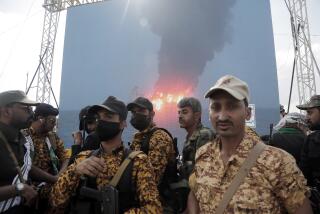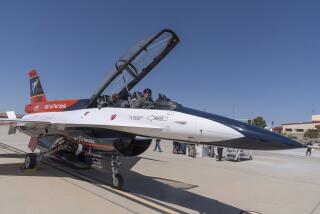Unmanned U.S. Plane Missing in Iraqi Territory
- Share via
WASHINGTON — An unmanned American surveillance aircraft was lost early Monday over southern Iraq in an incident that could mark the first success in Saddam Hussein’s 10-year effort to down the allied planes that patrol his territory.
Pentagon officials said the RQ-1B Predator, which failed to return from an early-morning mission, might have been shot down or might have crashed because of a malfunction.
Though the plane is a slow, low-flying craft, its loss is expected to help Hussein boost his prestige among his Arab neighbors as well as with Iraqis.
The loss also underscores the growing risks facing the U.S. and British pilots patrolling Iraq. Iraqi batteries are firing missiles and artillery at them almost daily. And it adds urgency to the Bush administration’s effort to formulate a new policy for containing Hussein’s military.
U.S. Central Command in Tampa, Fla., said the drone “may have crashed or been shot down” about 9 a.m. Iraq time. Though military analysts might be able to deduce what happened from the images and data the Predator was sending back at the time it disappeared, officials said they had not been able to reach any immediate conclusions.
“It’s possible that we’ll never know what happened,” said Marine Lt. Col. Dave Lapan, a Pentagon spokesman.
Hussein increasingly has been pressuring his military commanders and defense suppliers to help him down an American aircraft and capture a pilot.
He lost no time trying to use the incident to his advantage. Official Iraqi TV broadcast images of scorched aircraft wreckage, which it said had plummeted to Earth near the southern port of Basra.
The Predator “was flying a spy mission in Iraqi airspace,” an Iraqi military spokesman said.
In northern Iraq, meanwhile, U.S. planes attacked an SA-3 surface-to-air missile site near the city of Mosul after taking fire from antiaircraft artillery, U.S. military officials said.
U.S. and other allied planes have been patrolling northern and southern “no-fly” zones in Iraq since the 1991 Persian Gulf War to keep Hussein from moving militarily against neighbors or Iraqi groups.
Pilotless aircraft capable of transmitting live images and data to U.S. command posts are used to supplement information gained in air patrols by Air Force F-16s and other manned aircraft.
The unarmed plane, which is about 27 feet long and has a wingspan of about 49 feet, cruises at speeds ranging from 80 to 140 mph at altitudes up to 25,000 feet. By comparison, a U.S. F-15 fighter can fly at more than 1,300 mph.
Four Predators are used in a $25-million intelligence-gathering system for Iraq that also includes a ground control station and a radar link and is operated by 55 people.
The Predator is tough to hit with high-speed surface-to-air missiles, experts say. The greater risk to it is from antiaircraft artillery, which Iraq uses in large numbers.
In recent years, Hussein has intensified his efforts to strike back at the allied fliers by upgrading his air defense capabilities and using them more often.
According to the U.S. Central Command, which is in charge of U.S. military operations in southwestern Asia, the Iraqis have fired at U.S. and British planes 1,010 times since the end of 1998. They have fired at U.S. planes 375 times this year.
They have taken steps to improve the integration of their air defense radar and surface-to-air missile batteries, most notably by installing a Chinese-built fiber-optic cable.
In response, the United States has intermittently bombed Iraqi air defenses, and it has gradually shifted some of its surveillance and reconnaissance efforts to the drone aircraft, though officials declined to discuss this in detail.
U.S. military officials said they do not regard the loss as a serious setback for U.S. policy, even if it was due to Iraqi fire.
“That’s why the Predator is there: to be able to substitute for live pilots and crews,” said Lapan.
Even so, U.S. military officials have acknowledged that if Hussein continues to fire at U.S. planes, the odds are that he will eventually hit one and may even capture a pilot.
Bush administration officials took office determined to improve on the Clinton administration’s policy of regular patrols alternating with limited strikes on the Iraqi air defense network. Critics have argued that that policy has been expensive and stressful for U.S. fliers.
So far, the Bush administration has not come up with a better way of containing the Iraqi military, though officials insist they are hard at work on the issue.
Charles Duelfer, a former United Nations weapons inspector in Iraq, predicted that Hussein will gain prestige among his Arab neighbors as a result of the Predator’s loss. At a time when the Arab world is angry at the United States over Israeli-Palestinian violence, Iraq can win points by saying that “they’re the only ones standing up to the world’s sole superpower,” he said.
He said Hussein has in recent days been meeting with his military commanders and defense suppliers to pressure them to help him kill or capture an American pilot.
“Those guys are really feeling the heat,” said Duelfer, who is a scholar at the Center for Strategic and International Studies, a Washington think tank. “I wouldn’t like to be in their shoes.”
More to Read
Sign up for Essential California
The most important California stories and recommendations in your inbox every morning.
You may occasionally receive promotional content from the Los Angeles Times.











